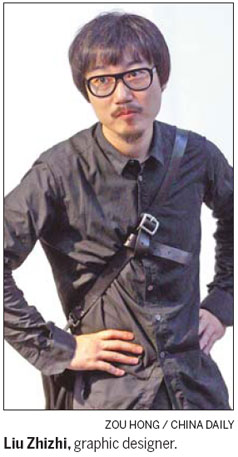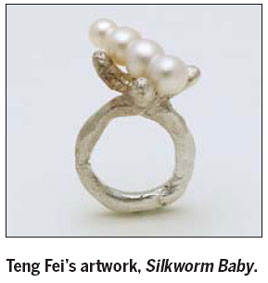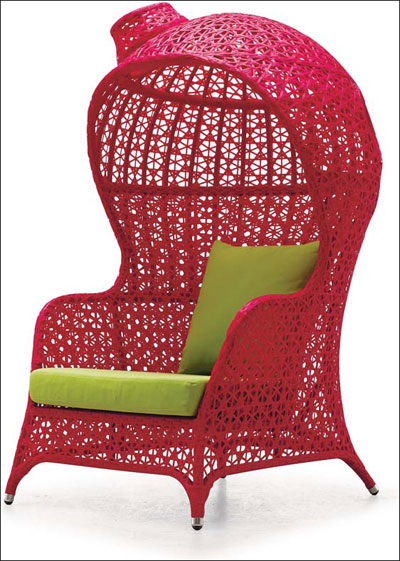Art
The fine line of design
Updated: 2011-06-14 08:05
By Chen Nan (China Daily)
|
Chinese designer Zhang Xiaochuan's installation artwork, Red Chair, will be displayed at the China New Design Exhibition. Provided to China Daily |
China's creative types strut their stuff at exhibitions in Italy, displaying the strides they've made past the 'made-in-China' label. Chen Nan reports.
Hardly any domestic luxury brands could claim space in the pages of Vogue magazine or on the shelves of top-tier retailers just a few years ago. But times - and the country's creative spirit - are changing. Now, Chinese designs are gracing the glossies and boutique displays, and will take center stage at the China New Design exhibition now under way at the Milan Triennale Design Museum, and the Turin Palace Museum (Palazzo Chiablese) from June until September.
The show, which is part of the 2011 Year of China in Italy, displays 134 works by 29 of China's most dynamic new generation designers. The creations come from mavericks in the country's publishing, graphic design, fashion, multimedia and public space and interior design spheres.

Fashion designer Zhang Da presents his newest clothing line, Ping. Wang Yiyang introduces a menswear line that fuses Chinese and Western traditions. And multimedia dynamo Zhu Jinjing exhibits his work, Nokia-Bruce Lee.
"If there is a common link among China's young designers, it's that they are down-to-earth, good at making use of their Chinese backgrounds and belong to the school of hyper-realism," says exhibition founder Cui Qiao, who is also the director of education and public programs at the Ullens Center for Contemporary Art (UCCA).
"These three months of design-oriented programs and events offer the Italian public an opportunity to learn about the latest trends in Chinese design and the new generation of Chinese designers, who are leading the way toward more innovative design."
UCCA has invited three curatorial consultants to design the exhibition. Chinese-American architect Yung Ho Chang is in charge of the exhibition hall space, and young designers Liu Zhizhi and Guang Yu are responsible for the graphic design.
"This is the first time the Chinese government has included an exhibition of modern domestic design in an international cultural exchange program of this kind," 35-year-old graphic designer Liu Zhizhi says.
Liu's works include posters for Beijing's 798 art district and for the Brand New China (BNC) clothing store in the capital's Sanlitun Village shopping district.
"The government usually promotes traditional Chinese culture - things such as lion dances and Peking Opera - in the West. I believe this is a chance for the world to see the most current stories about what's happening in China. These stories are told by young Chinese designers' works."
Liu is also a consultant for the exhibition. Some of the Beijinger's posters and book covers, which are imbued with a strong Chinese essence, will be shown.
Liu says graphic design didn't exist outside of government creations when he was growing up.
It was at the country's first-ever graphic design exhibition in Guangdong province's Shenzhen city that he first encountered the field.
"I knew immediately it was what I wanted to do," he recalls.
Liu opened his studio, the MEWE Design Alliance, with two classmates in 2002, after graduating from Beijing's prestigious Central Academy of Fine Arts (CAFA). Most of their early works were for artists, architects and designers whom they had known at the academy and who were also based in 798.
"One challenge I enjoy is reflecting clients' needs and spirit in their products," Liu says.
"I also regard graphic design as a medium of self-expression, which I believe is important for many young Chinese designers in any field."
Shanghai-based fashion designer Wang Yiyang shares Liu's view.
Wang's two brands - ZUCZUG and Cha Gang, which he launched in 2002 - have retail outlets on the mainland, and in Hong Kong, Japan and France.
"There are many discussions about the transition from made-in-China to designed-in-China," Wang says.
"We're only a quarter of the way down that road. But we're moving in the right direction."
He points out that "individuality" and "practical design" have become staples of the country's young designers.
"You start with all your creative ideas and a lot of idealism. Then you realize you have to be clever enough to combine those with a degree of commercialism to survive."
Jewelry designer Teng Fei, who is also the founder and dean of CAFA's jewelry design department, believes that what sets these designers apart from their predecessors is that they're not only competing in the domestic market but also are holding their own in the international market.
The 48-year-old points to CAFA as an example.

"It has an image as a source of edgy, risk-taking designers. Students here are trained in not only the technical but also the creative end of the field," Teng says.
Teng's Fairy Tale series of silver and pearl accessories are shown at the China New Design exhibition.
Jewelry design is - like many design genres - in its infancy in China. The Suzhou, Jiangsu province, native says she had no idea about its existence until she traveled abroad in 1990.
"My family wore simple, plain clothes with no accessories. It was studying in Germany that opened my eyes to fashion design's existence," she recalls.
Teng recalls that her career was initially made challenging by the fact that "the country isn't exactly known for producing world-class designers".
She developed a new theory when she returned to China in 1994 and established the jewelry major at the CAFA, she says.
"A piece of jewelry is designed for a certain person," she believes.
But her concept was not well received at first, she recalls.
"The previous generation was producing very nice - but not particularly adventurous - clothing. It never captured the fashion circle's imagination. Now, we've got young creative types, who are really exploiting China's avant-garde image."
Many domestic designers voice frustration that their products are snapped up by international buyers.
"All the designers want to reach a mass audience, but there is a gap between designers and Chinese consumers," Cui says.
"The lack of a market, products promotion and public awareness about original designs are among the gap's causes. But it will change."
Teng says more young people are becoming design majors following the rise of such gurus as Liu and Wang.
She plans to organize internships for students to work with the producers of such brands as Cartier to put them in touch with the design world's latest developments.
"Designers are now surrounded by many people of the same age and with the same mentality. They are working with photographers, magazines and boutiques who support and push them. It gives them the confidence and motivation to succeed."
E-paper

Pearl on the Yangtze
Wuxi is considered a town of natural beauty and its motto is "city of water and warmth".
Prose and consternation
Riding on a mystery train
Way of a warrior
Specials

When two are one
After a separation of 360 years, Huang Gongwang's famous Dwelling in the Fuchun Mountains has been made whole again.

Wealth of difference
Rich coastal areas offer contrasting ways of dealing with country's development

Seal of approval
The dying tradition of seal engraving has now become a UNIVERSITY major

